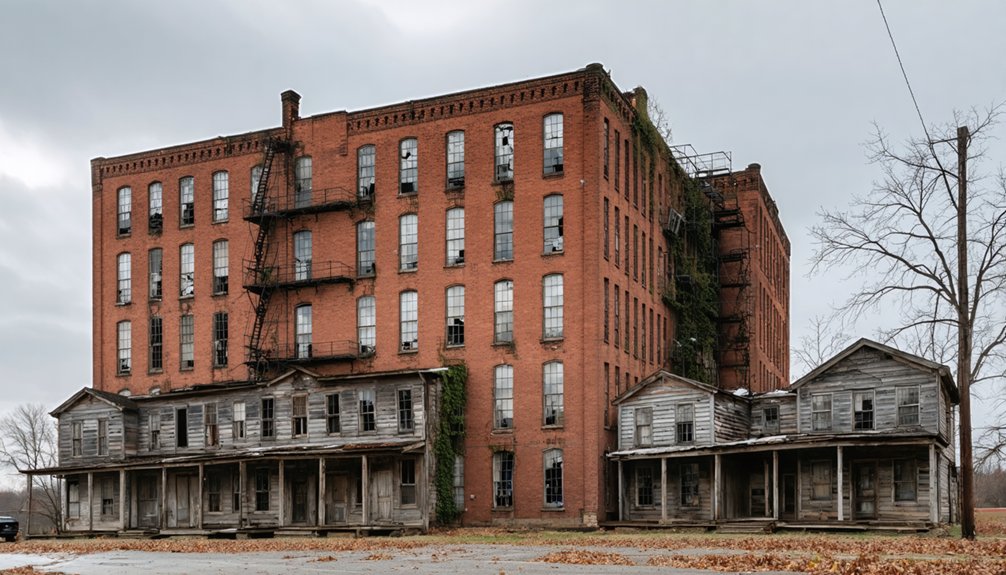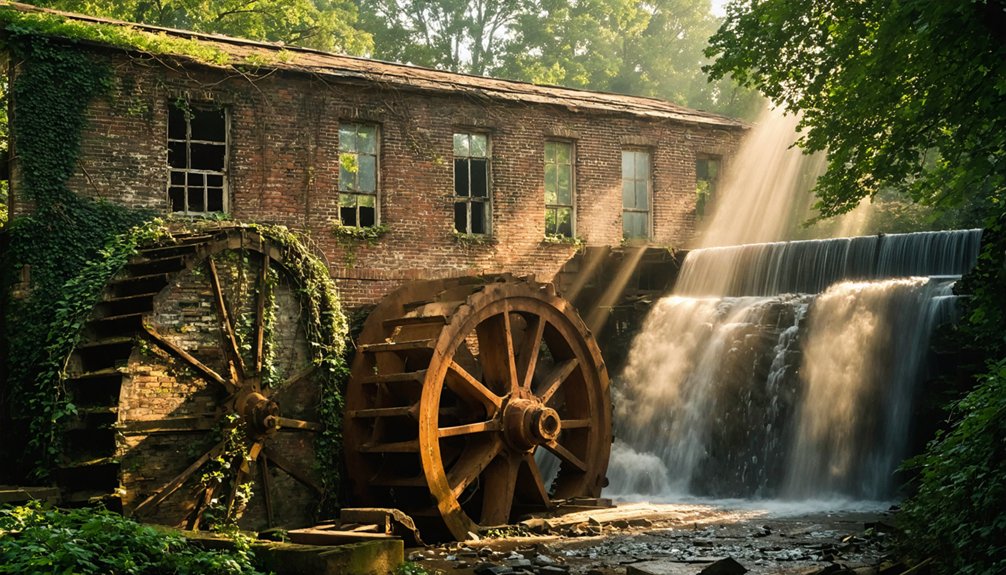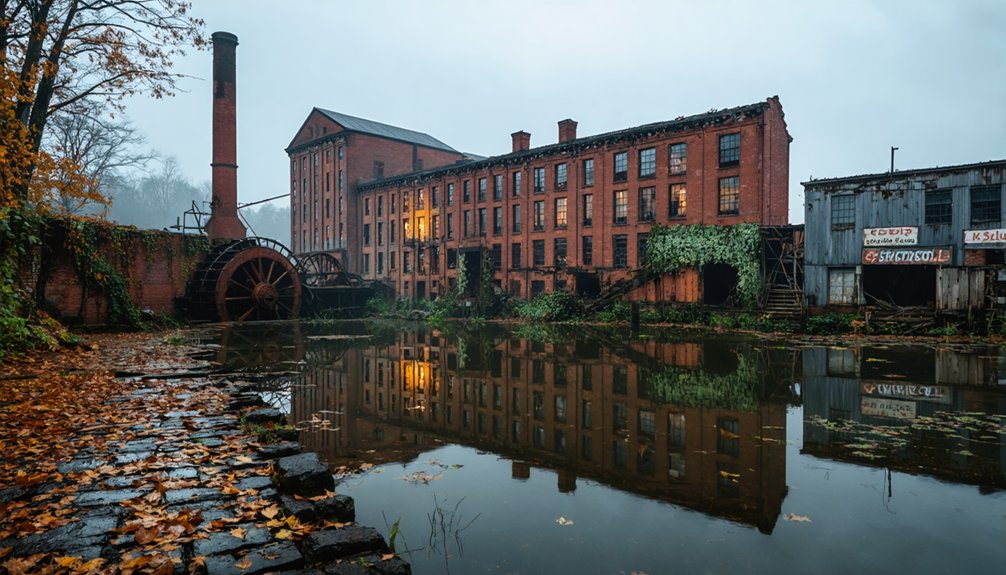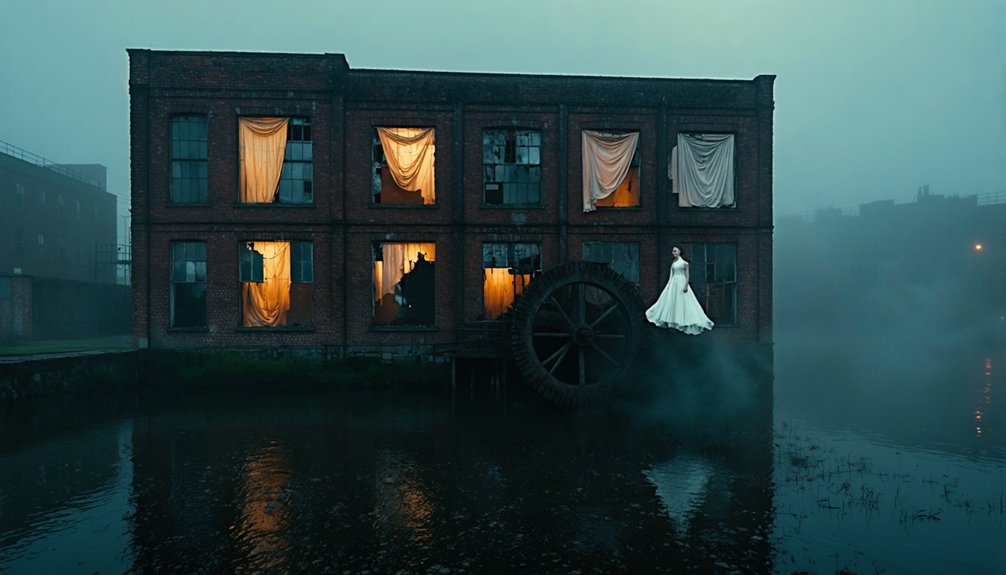When exploring abandoned mill towns in the US, you’ll discover architectural treasures from America’s industrial past. These sites reflect the economic rise and fall of textile manufacturing, from New England’s water-powered mills to southern company towns. Some locations, like Bodie, California, are preserved as heritage tourism destinations, while others, including Centralia, Pennsylvania, face ongoing environmental challenges. These forgotten landscapes reveal powerful stories about labor, innovation, and the dramatic socioeconomic shifts that transformed entire communities.
Key Takeaways
- Mill towns flourished during America’s industrial era but declined due to economic restructuring, international competition, and automation.
- Abandoned mills showcase architectural preservation opportunities with Classical Revival and Victorian styles maintaining structural integrity despite neglect.
- Historic industrial buildings are being adaptively repurposed into housing and commercial spaces while honoring their heritage.
- Photography documents these abandoned spaces, with specialists using techniques to capture vast interiors and the contrast between nature and decay.
- Tourism initiatives transform industrial landscapes into community assets, with successful examples like Lowell National Historical Park attracting 700,000 visitors annually.
The Rise and Fall of American Mill Towns (1860-1940)

While the American textile industry had its origins in small artisan workshops serving local markets, the period between 1860 and 1940 witnessed both the dramatic rise and eventual decline of specialized industrial communities known as mill towns.
You’ll find that mill town resurgence occurred first in New England, where water-powered factories like those in Lowell employed young women seeking economic independence.
After the Civil War, this development shifted southward as railroads expanded, with the Piedmont region experiencing remarkable textile industry revival. Mills tripled their spindle counts by 1890, creating company towns where corporations controlled housing and services. Many southern businessmen embraced up-to-date technologies when establishing these new industrial ventures.
These industrial communities featured distinct workforce patterns—New England employed young women, while southern mills recruited white farmers displaced by agricultural changes, deliberately avoiding African American workers unlike tobacco and coal operations. In Mississippi, the cotton textile industry served as a crucial economic bridge between agricultural and factory life, with few workers returning to sharecropping after experiencing mill work.
What Forces Drove the Abandonment of Industrial Communities
Although multiple factors contributed to the abandonment of America’s once-thriving industrial communities, economic restructuring stands as the primary catalyst that fundamentally altered the manufacturing landscape.
You’ll find that manufacturing employment plummeted nearly 33% between 1969-1996, devastating regions dependent on single industries. In cities like St. Louis, the closure of manufacturing plants resulted in the loss of over 43,000 jobs, leading to financial hardship and increased crime rates in affected neighborhoods. The effects of deindustrialization persist across generations, creating long-term unemployment and ongoing economic struggles.
Trade policies like NAFTA accelerated this economic decline, triggering closures of 650 textile plants and eliminating thousands of jobs. When Dan River Mills shuttered, four generations of workers lost their livelihoods simultaneously.
Free trade agreements devastated entire communities, wiping out multi-generational livelihoods with the stroke of a pen.
International competition and automation further undermined domestic production, while environmental regulations increased operational costs.
Cities like Muncie and Baltimore watched helplessly as their industrial bases collapsed.
Despite these challenges, many residents demonstrated remarkable community resilience, though they faced overwhelming forces that transformed once-prosperous manufacturing towns into abandoned industrial landscapes.
Notable Ghost Towns: From Bodie to Centralia

If you’re tracing America’s most iconic ghost towns, you’ll encounter Bodie, California‘s archetypal Gold Rush settlement where nearly $70 million in precious metals was extracted before its abandonment in the early 20th century. Originally named after W.S. Bodey who died in a winter blizzard while returning with supplies, the town’s name was misspelled and the error persisted. The town became infamous for its lawlessness, earning the notorious phrase “Badman from Bodie” by 1880.
In stark contrast, Centralia, Pennsylvania represents a more recent and ongoing disaster, where an underground coal seam fire ignited in 1962 continues burning today, gradually transforming a once-thriving mining community into an uninhabitable wasteland.
These abandoned settlements bookend the spectrum of American ghost towns—one preserved in “arrested decay” as a historical park, the other actively deteriorating as nature reclaims structures amid toxic gases and unstable ground.
Gold Rush Legacy
The American West’s most iconic ghost towns emerged from the frenzied gold and silver rushes of the 19th century, leaving behind skeletal remnants of once-thriving communities.
You’ll discover these settlements followed remarkably similar trajectories—explosive growth after mineral discoveries, followed by swift abandonment once deposits depleted. Bodie, California exemplifies the gold rush impact, transforming from a small camp into a boomtown of 10,000 before being preserved in “arrested decay” as California’s official Gold Rush Ghost Town.
Mining culture remains tangible in places like Virginia City, where the Comstock Lode created unprecedented wealth, and Goldfield, which briefly became Nevada’s largest city. Monte Cristo witnessed similar boom-bust patterns when major flooding in 1896 triggered its eventual decline. Kennecott processed nearly $200 million in copper before its eventual abandonment as resources diminished.
These abandoned communities—from South Pass City, Wyoming to Custer, Idaho—stand as three-dimensional textbooks, documenting America’s mineral-driven westward expansion.
Ongoing Mine Fires
While gold and silver depletion led to the abandonment of most Western ghost towns, Centralia, Pennsylvania offers a dramatically different narrative—a community evacuated due to an underground inferno that continues burning today.
Ignited in 1962, this subterranean blaze spans 3,700 acres and reaches depths of 300 feet. The fire’s origin remains unclear, with multiple theories circulating about how it began in May of that year. You’ll find that toxic exposure to carbon monoxide and sulfurous gases rendered the town uninhabitable, while the constant threat of mine collapse created deadly hazards, including an 80-foot sinkhole in 1981. The eerie sight of smoke rising from ground creates an apocalyptic atmosphere that draws curious visitors despite the dangers.
Despite $7 million in suppression attempts, authorities ultimately relocated residents rather than extinguish the fire.
Today, fewer than five residents remain where 2,700 once lived. The Pennsylvania Department of Environmental Protection warns potential explorers with a simple message: “Stay Out – Stay Alive.”
This fire could burn for another 250 years.
Architecture and Infrastructure: Remnants of a Bygone Era
When you visit former mill towns, you’ll encounter architectural preservation techniques that maintain the structural integrity of Classical Revival and Victorian styles while rehabilitating crumbling limestone walls and deteriorating roofs.
Despite decades of neglect, these historic buildings showcase ornate Victorian facades, decorative commercial elements, and the stark contrast between management’s mansions and workers’ modest clapboard houses.
The bridges spanning these communities—both literal stone structures and metaphorical connections between past and present—demonstrate how adaptive reuse transforms granite mills and brick factories into modern spaces while honoring their industrial heritage.
Architectural Preservation Techniques
Preserving the architectural integrity of abandoned mill structures requires specialized techniques that balance historical authenticity with structural necessity.
You’ll find preservationists following the Secretary of the Interior’s Standards, which outline four treatment approaches: preservation, rehabilitation, restoration, and reconstruction—each selected based on the building’s significance and condition.
Material conservation typically begins with cleaning facades to remove environmental damage while retaining original elements whenever possible. Rather than wholesale replacement, experts focus on repairing deteriorated cladding and finishes to maintain embodied craftsmanship.
Structural stabilization often involves traditional carpentry methods like mortise joints with pins, alongside bespoke elements such as cross beams that reinforce weakened frameworks while meeting safety standards.
Before aesthetic considerations, making these historic structures sound becomes the priority, ensuring they’ll withstand time while maintaining their authentic architectural character.
Bridges Spanning Time
Standing as silent witnesses to America’s industrial past, the bridges of abandoned mill towns represent more than mere transportation infrastructure—they embody the engineering prowess, economic priorities, and social fabric of their eras.
As you explore these industrial relics, you’ll find centenarians like Baltimore County’s 1922 Paper Mill Road Iron Bridge, with its ornamental portal bracing still intact, demonstrating remarkable structural integrity despite its age.
Bridge preservation often results from passionate community advocacy, as seen with Milltown’s Black Bridge, where locals petitioned to save their historic pedestrian crossing.
Engineering adaptations balance historical significance with modern needs—removing river piers while maintaining original trusses.
These structures, whether still in use or hidden beneath newer spans, connect you physically and metaphorically to the industrial communities that once thrived around them.
Preservation Efforts and Heritage Tourism

As abandoned mill towns fade into America’s industrial past, thorough preservation efforts have emerged as essential strategies for their revitalization and cultural sustainability.
These preservation initiatives transform deteriorating industrial landscapes into vibrant community assets through adaptive reuse of historic mill structures. You’ll find approximately 77% of Lowell’s mill space has been rehabilitated, with ongoing projects pushing toward 84% restoration.
Adaptive reuse breathes new life into our industrial past, with Lowell’s impressive 77% mill rehabilitation showcasing preservation’s transformative power.
The tourism impact of these efforts is substantial—Lowell National Historical Park alone attracts nearly 700,000 visitors annually.
When you explore these revitalized districts, you’ll encounter interpretive programs showcasing industrial heritage alongside new housing and commercial spaces.
Public-private partnerships facilitate these transformations, leveraging federal programs like the EPA Brownfields Grant to remediate environmental damage while preserving architectural significance.
This collaborative approach reduces urban blight while creating jobs and stimulating investment in formerly abandoned areas.
Photographing the Past: Documenting Mill Town History
Photographic documentation serves as a powerful witness to the vanishing world of America’s mill towns, capturing both architectural remnants and human narratives through carefully composed images.
When you explore these forgotten places, you’ll notice photographers often employ wide-angle lenses to encompass vast interiors and black-and-white processing to evoke temporal distance.
Mill photography thrives on contrasts—nature reclaiming industrial decay, empty factory floors alongside resilient communities.
Photographers like Matthew Christopher and Vincent David Johnson have dedicated years to chronicling these spaces, creating visual archives of economic transformation. Their work in locations like Willimantic’s “Thread City” and Gary’s steel complexes captures long exposures of stillness and detailed shots of machinery—preserving historical context that might otherwise disappear forever.
These images tell stories of abandonment while simultaneously celebrating the enduring character of America’s industrial heritage.
Frequently Asked Questions
What Safety Precautions Should Visitors Take When Exploring Abandoned Mill Towns?
Wear appropriate safety gear including boots, gloves, masks, and clothing. Conduct thorough structural assessments before entry. Bring flashlights and first aid kits. Urban exploration requires legal permission and environmental respect.
Can Artifacts Be Legally Collected From Abandoned Mill Town Sites?
You can’t legally collect artifacts without permission. Artifact ownership depends on land status, with severe legal ramifications for removal from federal, state, or private property without proper authorization.
Are There Seasonal Considerations for Visiting These Historical Locations?
Like seasons of life, timing is essential. You’ll face seasonal accessibility challenges, with summer and fall offering ideal weather patterns while winter requires specialized equipment and spring brings unpredictable conditions.
How Do Local Residents Feel About Tourism to Abandoned Communities?
Local residents often hold mixed community perspectives; they appreciate economic revitalization but worry about tourism impacts including cultural commodification, housing affordability challenges, environmental degradation, and potential loss of authentic community identity.
What Restoration Techniques Preserve Structures Without Compromising Historical Authenticity?
You’ll preserve historical authenticity through documented adaptive reuse, employing original materials, traditional joinery, minimal intervention, and selective modern reinforcements that remain invisible while ensuring structural integrity and longevity.
References
- https://millmuseum.org/history-2/sweat-of-their-brows/rural-communities/
- https://www.mentalfloss.com/geography/wanderlust/creepiest-ghost-towns-united-states
- https://www.geotab.com/ghost-towns/
- https://en.wikipedia.org/wiki/Ghost_town
- https://www.britannica.com/topic/ghost-town
- https://www.lovemoney.com/gallerylist/86648/americas-empty-ghost-towns-and-why-theyre-abandoned-today
- https://www.loveexploring.com/gallerylist/188219/the-us-state-with-the-most-ghost-towns-revealed
- https://www.smithsonianmag.com/travel/americas-coolest-ghost-towns-180952954/
- https://www.wm.edu/sites/wmcar/research/danvilledig/history/southern-mill-industry/
- https://narvellstrickland1.tripod.com/cottonmillhistory2/index1.html



